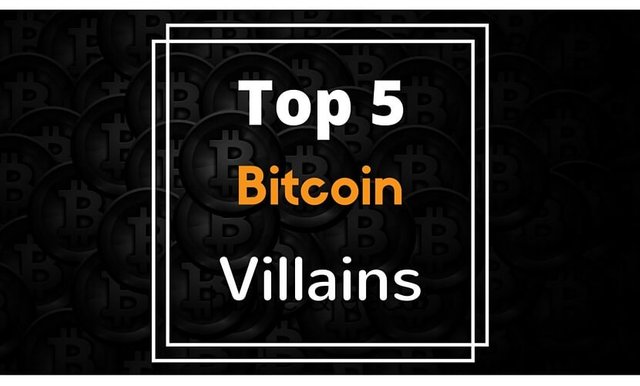Top 5 Biggest Bitcoin Villains to Date
Since Bitcoin started to become famous in mainstream there have bee well-known villains (in no particular order) that have had a negative influence on the image of Bitcoin and the cryptocurrency industry as a whole. Here are a compilation of the top 5 Bitcoin villains to this date.

As the world’s first ever, truly-global, decentralized, peer-to-peer currency, Bitcoin has certainly had its share of ups and downs. Some of Bitcoin’s most memorable moments have involved individuals who have used or smeared the technology for their own personal interest at the expense of the community at large. But while these individuals could certainly be called “villains” by many, it is also important to keep in mind that Bitcoin and cryptocurrency technology as a whole does not care: there’s no central control, no CEO, it is apolitical, interest-agnostic, and, at the end of the day, just a convenient protocol to transfer value online.
Nevertheless, we at Bitcoin.com hope that by shedding light on these individuals’ attempts to either smear Bitcoin, use it for fraud and personal interest, it will make the network stronger and prevent the community from falling victim to these devious practices in the future.
Mark Karpeles

The former CEO of the defunct Mt. Gox exchange is probably the most infamous individual in Bitcoin history. Mt. Gox was a bitcoin exchange launched in July 2010. By 2013, it was handling 70% of all bitcoin transactions and in February 2014, the Mt. Gox company suspended its operations and filed for bankruptcy protection from creditors.
It was revealed that around 850,000 bitcoins (worth about $450 USD million at the time) were missing and likely stolen with many people pointing the finger at Karpeles as the orchestrator of this possible inside job. He was finally detained by the Japanese authorities on August 1, 2015 for suspicion of corporate embezzlement and other laundering charges.
This incident certainly tarnished Bitcoin’s image, as the public still associates its name with theft, fraud and lost funds. Even though Bitcoin itself did not fail in any way and was not responsible for the centrally-held users’ funds entrusted to the exchange, the community is still recovering from the unfortunate event. There are talks about a possible Hollywood movie being made in the future about the story of Mark Karpeles and the defunct Mt. Gox exchange.
Trendon Shavers

Trendon Shavers was the operator of the largest scam in Bitcoin history. His Bitcoin Savings & Trust (BTCST) allegedly raised 764,000 bitcoins, worth roughly $4.5 million USD at the time, from investors. He promised returns of 7% per week (3,641% per year), claiming to use his market arbitrage skills.
While investing only some of these funds, Shavers was “receiving money from investor B to pay investor A,” said assistant US Attorney Michael Ferrara. In September 2015, Shavers pleaded guilty to running a $150 million Ponzi scheme.
Ryan Kennedy (aka Alex Green)

Ryan Francis Kennedy, aka Alex Green, aka Ryan Gentle (according to multiple sources who claim they knew him as a fellow student at City College Plymouth) is the alleged mastermind behind the defunct Dogecoin trading platform, Moolah. He is responsible for stealing approximately $1.4 million USD from Moolah customers.
The money in question initially belonged to users of a different exchange, called Mintpal, which was hacked and pilfered of $2 million back in July 2014. Kennedy and a few other accomplices purchased the exchange a few weeks later, integrating 70,000 Mintpal accounts into their exchange. Shortly after, Moolah went bankrupt and the rest is history.
He was also accused of stealing over 750 BTC (approx. $285,000 USD at the time) from the Dogecoin community and was dubbed as “the guy who ruined Dogecoin” by Motherboard.vice. Moreover, he has also been charged with 14 counts of sexual misconduct against 5 women, including 11 counts of rape.
Steve Chen

The mastermind behind the Gemcoin scam, Steve Chen, was charged along with nine others with running a Ponzi scheme that targeted US and Chinese citizens involving the fake cryptocurrency Gemcoin. The victims filed a $100 million USD class-action lawsuit right after the SEC began its crackdown. According to the complaint, Gemcoin was used to attract investors, which they were to receive prior to its promised rise in value.
The complaint reads:
"Defendants themselves, and through their entities and agents, sold worthless assets called Gemcoins […] Defendants heralded Gemcoin as a new cryptocurrency they invited that would be revolutionary and grow exponentially in value, and that Plaintiffs could become early investors."
Josh Graza

Homero Joshua Garza was brought up on civil charges for the alleged operation of a Ponzi scheme by the SEC. Garza and his associated companies — GAW Miners and ZenMiner — are currently being tried in court for selling $20 million USD worth of a cloud mined product called “hashlets.”
The complaint reads:
The defendants’ hashlet sales had many of the hallmarks of a Ponzi scheme.
“As alleged in our complaint, Garza and his companies cloaked their scheme in technological sophistication and jargon, but the fraud was simple at its core: they sold what they did not own, misrepresented what they were selling, and robbed one investor to pay another,” added Paul G. Levenson, Director of the SEC’s Boston Regional Office assigned to the case.
The SEC alleges that Garza initiated conspired fraud with these “hash-shares” and was also involved with a series of other plotted events, which included his altcoin Paycoin and the Paycoin Foundation.
Source Altcoin Today
That was an awesome article. It sucks that it happened, but it is interesting nonetheless. I guess it's along the lines of reading a book about serial killers. Morbid but fascinating.
Glad you liked it. I hope everyone stays safe from these sort of scams.
Mintpal got me for few coins back then....